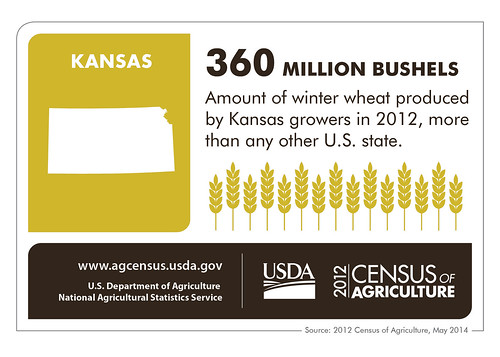
The Census of Agriculture is the most complete account of U.S. farms and ranches and the people who operate them. Every Thursday USDA’s National Agricultural Statistics Service will highlight new Census data and the power of the information to shape the future of American agriculture.
The Kansas state seal and state flag both feature a farmer, and looking at the results of the most recent Census of Agriculture, it is not hard to see why. In 2012, the year for which the Census was conducted, there were almost 62,000 farms covering more than 46 million acres of land in Kansas. That year Kansas producers sold close to $18.5 billion worth of agricultural products.
Crops have long been a symbol of Kansas farming. According to the Census, in 2012 Kansans produced almost 360 million bushels of winter wheat from more than 9 million harvested acres. More than 20 percent of all winter wheat in the U.S. that year came from Kansas – more than double both the acreage and production of Oklahoma which was the second-largest winter wheat producer in the nation.
As is the case with most Midwestern states, Kansas has very favorable conditions for both corn and soybeans. In 2012, Kansas farmers harvested more than 3.9 million acres of corn and 3.8 million acres of soybeans, ranking in the top 10 for both of these crops.
And of course I’d be remiss not to include sunflower seed production. After all, Kansas calls itself “The Sunflower State” and sunflower is the state flower. Together, North and South Dakota produce more than 80 percent of all sunflower seeds in the nation. Despite that, Kansas still holds a respectable third place, with Kansans producing more than 111 million pounds of sunflower seeds in 2012.
Despite so much variety in our crops sector, it is Kansas livestock producers who are responsible for the majority of all agricultural sales in the state. In this sector, however, there’s much less diversity. Out of nearly $11.5 billion in sales of livestock products in 2012, almost 90 percent came from Kansas cattle and calves. In 2012, sales of Kansas cattle and calves were second largest in the nation, with only Texas coming out ahead.
With that said, I don’t want you to think that there are no other animals in Kansas. The sunflower state is in the top 10 states in the nation when it comes to hogs and pigs. According to the Census, Kansas also boasts 4th largest pheasant inventory in the United States. So while cattle and calves dominate the Kansas livestock sector, there are still plenty of other livestock raised here.
These are just the data from the main portion of the Census. I haven’t even begun to talk about irrigation, horticulture, or aquaculture in Kansas. I also can’t wait to get the results of the Organic Survey, which are scheduled to come out later this year. If you are interested in all or any of these sectors, both Census and its additional follow-on studies are published online, so you can always check those data out.

